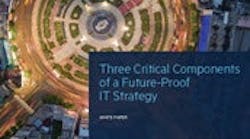Three Critical Components of a Future-Proof IT Strategy
Today’s CTOs and CIOs face greater challenges than ever before, particularly when it comes to managing their IT infrastructure. What applications should run on premise? Which workloads should move to the cloud? What kind of strategy is best?
We live in a world now where both internal and external customers expect instantaneous access from anywhere in the world and from any number of devices. So enterprises are faced with how to optimize cost, security and latency. It’s no surprise that 82% of organizations now have a multi-cloud strategy.1 However, managing hybrid cloud adoption requires the savvy of an industry analyst who can see future trends, the acumen of a top cloud consultant able to navigate the complexities, and the mind of a strategist able to balance enterprise requirements, innovation and ROI across multiple environments.
Yet, in spite of the myriad of challenges surrounding adoption, organizations are undertaking the effort to move more of their workloads to the cloud. Today 39% of enterprise workloads run in the cloud; in two years, that number will climb to 57%,2 though cloud strategies are neither linear nor fixed. About one-fifth of early public cloud adopters have already moved applications from a public cloud into a private cloud, either on premise or hosted. The number one driver for this migration is security and the second is the cost of high-volume public cloud computing. Practical and necessary as it now seems, in practice, implementing an effective hybrid cloud strategy is complex and time-consuming.
Hence, in this constantly changing marketplace, organizations need a data center solution that can help futureproof their IT strategies by offering a full range of flexible choices to meet both current and future business requirements, without causing disruption or having them compromise on support.
